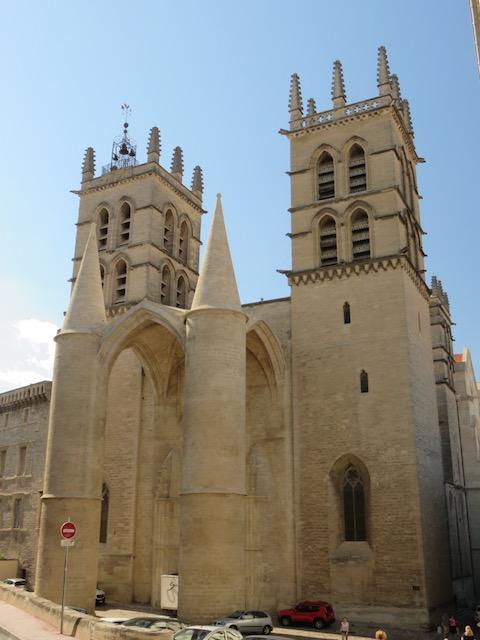 |
What to See & Do in Montpellier | |
| Many of the city's premier sights are within easy walking distance of the central Place de la Comédie. | ||
|
|
|
Montpellier is a fascinating city, full of winding narrow medieval streets and alleys in many areas, and also home of majestic 19th century buildings, many ornately decorated. The warren of small streets makes navigation both fun and challenging. Our taxi ride from the Gare Sud de France to the Hotel du Palais took a most circuitous route, including sharing the road with tram tracks. On foot, it can be confusing, but take heart: after walking around for a while, we realized most major sites were much closer together than it appeared. You'll want to get a map from the Tourist Information Office, and you may also want to consult maps and directions on your smart phone. Place de la ComédieStart your Montpellier wanderings at the vast Place de la Comédie, with its iconic Fontaine des Trois Grâces (Fountain of the Three Graces), those of Greek mythology: Aglaea, Euphrosyne and Thalia, personifying beauty, charm, creativity, nature, fertility and goodwill. The Place de la Comédie is undergoing extensive renovations from 2022 through 2025: new plantings of elm trees, islands of shade and calm, fountains and other improvements are being added. The Opéra Comédie, built in 1888, replaced two previous opera buildings on the site, those of 1785 and 1855, both of which were destroyed by fire. The Opéra is now the home of the Orchestre national Montpellier Occitanie. (Performances of opera take place in the modern Opéra Berlioz in the Corum complex.) Farther along the Place to the northeast, you can't miss the 19-century baroque extravagance of the Gaumont Comédie cinema. Adjoining the Place to the northeast, the broad Esplanade de Charles de Gaulle is a welcome green park in the city center. Fountains, benches, and paths provide a lovely place to stroll. Cathedral and ChurchesThe 14th-century Gothic Cathédrale de Saint-Pierre is 800 meters (1/2 mile) northwest of the Place de la Comédie, near the Jardin des plantes de Montpellier, France's oldest botanical garden, founded in 1593. The cathedral is a striking building, looking more fortress-like than most, with two huge cylindrical towers at the front and two square towers atop. The original structure was built in 1364, under Pope Urbain V (whose coat of arms once graced the cylindrical towers). It became a cathedral in 1536. The interior includes a large and beautiful organ (regular concerts are offered) and some lovely stained glass. Some of the interior structure dates from the 19th century. The building abuts the fascinating École de Medicine, the oldest Medical School in the western world which is still operating today. Lord Guilhem VII decided in 1181 that anyone, regardless of religion or origins, had the right to teach medicine in Montpellier. This led to the establishment of the medical school in 1220. Walk into the main lobby and you can see plaques identifying the first doctors of Montpellier, the oldest of whom Adalbert de Mayence, was apparently practicing from 1128 to 1141.
The neo-Gothic Église Saint-Roch de Montpellier, 500 meters (548 yards, less than 10-minute walk) west of the Place de la Comédie, houses relics of Saint Roch (1348-1379), who was born in Montpellier. As of 2022 it was closed for renovations; check to see if it is open. Arc de Triomphe/Place PeyrouA short distance south of the cathedral, in the Jardin de Peyrou, the Porte du Peyrou is a monumental triumphal arch dating from 1693, later modified by King Louis XIV with sculptures glorifying his military conquests. The Arc opens into the Place Royale de Peyrou, a lovely tree line park that offers lovely views of the surrounding area. At its center is a monumental statue of King Louis XIV on horseback. Louis is aligned with the Arc and also with the 18th century water tower, which held the water reserves for the city. The water tower was fed by the Saint-Clément Aqueduct, built in 1754, which supplied water from springs in the town of St-Clement. The aqueduct was still in use until the 1970s! (Note: You can move between the Arc and the tram line below by elevators located almost beneath the Arc.) Musée FabreThe Musée Fabre, 400 meters (438 yards, a 6-minute walk) north of the Place de la Comédie, is Montpellier's foremost art museum with a large collection of paintings by well-known and regional artists. Founded in 1825 by the neoclassical painter François-Xavier Fabre, the musem has benefitted over the years from many donations and bequests. Starting with Fabre, many other artists donated both their own works and their personal collections. The collection ranges from Old Masters to Nordic Paintings, from Renaissance to Neo-classical art, and more modern and contemporary art. Its most recent acquisitions include donations from Pierre Soulages, an artist with roots in Montpellier Over time, the Museum expanded to house its large collections. The Museum now occupies two large adjacent buildings, as well as the nearby Hotel de Cabrières-Sabatier, which houses its department of decorative arts. The main buildings are large, so you'll want to allow plenty of time to explore the various halls and the different wings. It can be a big confusing to find your way around, but helpful staff are there to answer questions and direct visitors. Signage is in French, though there is a printed guide/map that is available in English and other languages. Parks and GardensMontpellier has a lovely botanical garden (Jardin des Plantes in French), located just across the tram tracks from the Cathedral and the Medical School. It was created in 1593 at the request of King Henri IV to focus on medicinal plants. It is the oldest botanical garden in France, predating the Jardin des Plantes in Paris by 33 years. Note that it is closed on Mondays, and only open in the afternoons on other days. The Esplanade Charles De Gaulle is a tree-lined park that connects the Place de la Comédie and the Corum area (a conference center and home of the Opéra Berlioz, Montpellier's second opera house, built in 1990). The park abuts the Jardin du Champs de Mars, with its pond and children's play areas. There are also a number of cafes along the Esplanade. Sète - a Beach GetawayA visit to Montpellier wouldn't be complete without a trip to the nearby Mediterranean coast. The beautiful little town of Sète, 16 minutes from Montpellier by train, with its beautiful 13-km (8-mile) long beach, is the perfect destination. More...
|
|
Start in the Place de la Comédie with the Fountain of the Three Graces.
|


